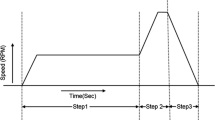Abstract
This paper presents a 4-bit micro-electromechanical system (MEMS) digital attenuator with improved attenuation accuracy by surface micromachining. The attenuator is consisted of monoblack type radio frequency MEMS switches and TaN film resistors fabricated on a glass substrate to control the reconfigurable power within DC ~ 18 GHz. The simulation results revealed that the device had favorable terminal matches ranging from 0 to 70 dB with a 10 dB step. The attenuation accuracy was better than 1.2 dB, the insertion loss was less than 1.32 dB, and the voltage standing wave rations were better than 1.56 under these eight attenuation steps. Additionally, the package size of this device was designed as 8.28 mm × 2.37 mm × 0.85 mm, such that it could be applied to miniaturized microwave instruments.









Similar content being viewed by others
References
Guo, X., et al. (2016). A miniaturized reconfigurable broadband attenuator based on RF MEMS switches. Journal of Micromechanics and Microengineering,26(7), 074002.
Mizukami, M., et al. (2011). 128 × 128 three-dimensional MEMS optical switch module with simultaneous optical path connection for optical cross-connect systems. Applied Optics,50(21), 4037.
Rebeiz Gabriel, M., et al. (2009). Tuning into RF MEMS. IEEE Microwave Maga-zine,10(6), 55–72.
Bansal, D., et al. (2014). Design of novel compact anti-stiction and low insertion loss RF MEMS switch. Microsystem Technologies,20(2), 337–340.
Koutsoureli, M., et al. (2015). Induced charging phenomena on SiNx, dielectric films used in RF MEMS capacitive switches. Microelectronics Reliability,55(9-10), 1911–1915.
Yang, H. H., Zareie, H., & Rebeiz, G. M. (2015). A high-power stress-gradient resilient RF MEMS capacitive switch. Journal of Microelectromechanical Systems,24(3), 599–607.
Yang, H. H., et al. (2015). Symmetric and compact single-pole multiple-throw (SP7T, SP11T) RF MEMS switches. Journal of Microelectromechanical Systems,24(3), 685–695.
Zhang, N., et al. (2017). A switchable bandpass filter employing RF MEMS switches and open-ring resonators. IEEE Transactions on Electron Devices,99, 1–7.
Iannacci, J., Giacomozzi, F., & Colpo, S., et al. (2009). A General Purpose Reconfigurable MEMS-Based Attenuator for Radio Frequency and Microwave Applications. EUROCON 2009, EUROCON ‘09. IEEE, (pp. 1197–1205).
Dai, C. L., & Chen, J. H. (2006). Low voltage actuated RF micromechanical switches fabricated using CMOS-MEMS technique. Microsystem Technologies,12(12), 1143–1151.
Ghodsian, B., & Hyman, D. (2008). Wideband DC-contact MEMS series switch. Micro & Nano Letters Iet,3(3), 66–69.
Mabrouk, M., Boujemaa, M. A., & Choubani, F. (2016). Flexible engineering tool for radiofrequency parameter identification of RF-MEMS BAW filters. ETRI Journal,38(5), 988–995.
Rocha, L. A., et al. (2011). Auto-calibration of capacitive MEMS accelerometers based on pull-in voltage. Microsystem Technologies,17(3), 429–436.
Junfeng, S., et al. (2015). Design of DC-contact RF MEMS switch with temperature stability. AIP Advances,5(4), 57–434.
Juiche, T., et al. (2007). Analysis of the interchannel response in a MEMS 1 × N2 wavelength-selective switch. Applied Optics,46(16), 3227–3232.
Zohur, A., et al. (2013). RF MEMS reconfigurable two-band antenna. IEEE Antennas & Wireless Propagation Letters,12(1921), 72–75.
Bansal, D., et al. (2015). Design of compact and wide bandwidth SPDT with anti-stiction torsional RF MEMS series capacitive switch. Microsystem Technologies,21(5), 1047–1052.
Pal, J., et al. (2015). RF MEMS switches for smart antennas. Microsystem Technologies,21(2), 487–495.
Acknowledgements
This work was supported by the Information System Pre-research Project (No. 31513060101). We thank the Key Laboratory of Instrumentation Science & Dynamic Measurement for their support.
Author information
Authors and Affiliations
Corresponding authors
Additional information
Publisher's Note
Springer Nature remains neutral with regard to jurisdictional claims in published maps and institutional affiliations.
Rights and permissions
About this article
Cite this article
Li, M., Zhang, Y., Zhao, Y. et al. Design and fabrication of a 4-bit RF MEMS attenuator with a high attenuation accuracy. Analog Integr Circ Sig Process 102, 617–624 (2020). https://doi.org/10.1007/s10470-020-01608-x
Received:
Revised:
Accepted:
Published:
Issue Date:
DOI: https://doi.org/10.1007/s10470-020-01608-x




